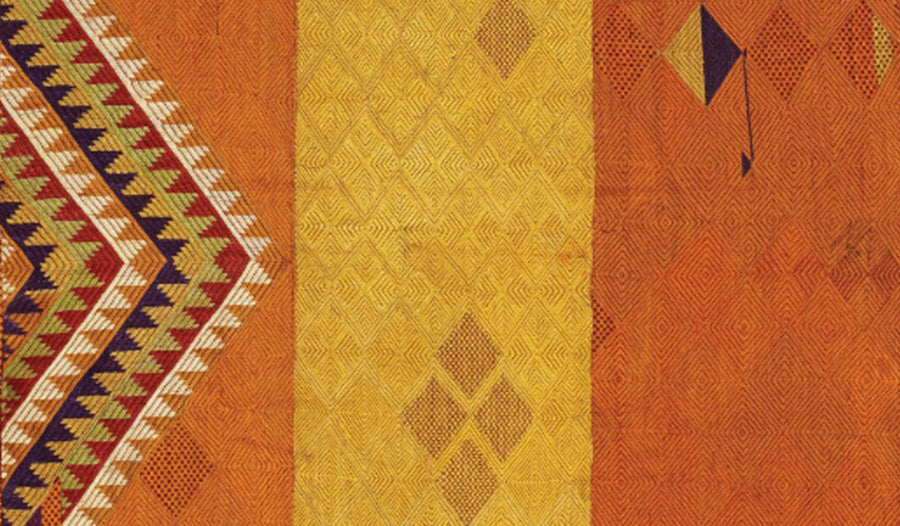
South Asian Heritage Month 2021
 Image: Women's shawl (bagh). Part of the SOAS Baghs - Abstract Gardens exhibition. Pre-partition Punjab, mid 20th century. Cotton with floss silk embroidery.
Image: Women's shawl (bagh). Part of the SOAS Baghs - Abstract Gardens exhibition. Pre-partition Punjab, mid 20th century. Cotton with floss silk embroidery.
South Asian Heritage Month runs from 18th July to 17th August every year. It seeks to raise the profile of British-South Asian history in the UK through education, arts, culture and commemoration. By marking the achievements of South Asians, past and present, it aims to help people to better understand the diversity of present-day Britain. From 'Baghs - Abstract Gardens' a display exploring embroidered shawls from pre-partition Punjab at SOAS's Brunei Gallery, to 'Roots & Changes: Gujarati Influences' exploring tradition textiles processes at Brent Museum, they are promoting several textile based exhibitions as part of the month of celebrations.

Image: Harsha Chaniyo, courtesy of the Museum of Brent
Roots and Changes - Gujarati Influences
13 March 2021 – 22 August 2021
The exhibition Roots and Changes - Gujarati Influences, taking place at the Museum of Brent, explores how the Gujarati diaspora in the UK has considerably shaped and influenced the cultural landscape of London. These stories are presented in a multi-dimensional exhibition, focussing on the London Borough of Brent.
The underlying feature of this show is to tell the ‘Gujarati story’ of a successful migration, which has influenced, enriched and shaped the UK. It considers work and leisure patterns. Work includes cultural traits such as traditional crafts, trade, architecture, local politics, commerce, employment, entrepreneurship and leisure comprises cultural expressions such as music, dance, family and spiritual life.

The project will show the diverse cultural roots of the Gujarati community in the Indian state of Gujarat and the countries along the east and south coasts of Africa. Changes highlights how the settlement of the Gujaratis in the UK, from the 1960s onwards, changed its own community, but also how they influenced their host and other immigrant communities.
Developed and curated by Lata Desai and Rolf Killius in partnership with Subrang Arts and Brent Museum and Archives. This project also links with collections and activities at the British Museum, drawing together national collections with community knowledge. The two museums spearhead cross-cultural exchange and engagement with culture and heritage of the Gujarati community.
 Image: Women's shawl or head-cover. 19th century. Cotton with floss silk embroidery.
Image: Women's shawl or head-cover. 19th century. Cotton with floss silk embroidery.
Baghs - Abstract Gardens: Embroidered shawls from Punjab
13 July - 25 September 2021
SOAS’s Brunei Gallery is pleased to present the exhibition Baghs - Abstract Garden, which is displaying a collection of baghs and phulkaris, domestic embroidered shawls from pre-partition Punjab. Largely domestic embroideries, most of these shawls were embroidered by young Sikh, Hindu and Muslim girls and women for weddings and other ceremonies. The exhibition will show some exceptional and historical head coverings from the Karun Thakar collection.
Bagh ‘garden’ and phulkari, ‘flower-work’ are cotton head coverings that were made in pre-partition Punjab (the historical region that now includes Pakistan Punjab including the further northern edge of Hazara and part of the modern Indian states of Punjab, Haryana and Himachal Pradesh). Women carried out the cotton picking and spinning which would then be hand woven into coarse cotton cloth called khaddar. Rangarez, dyers would then dye the cotton to various red colours as well as indigo. All the embroidery was done from the back by counting threads in darning stitch using floss silk (heer). This technique was perfect for showing most of the silk in the front as only a single thread would be caught in the back. The front surface would show a much longer float of the thread, giving the traditional stitch by building solid blocks of parallel rows of darning stitches.

This example of a women’s shawl (bagh) from pre-partition Punjab is made from cotton and is embroidered using floss silk and glass beads. This bold bagh has chequerboard, zigzag and stripe designs in the central body. Two rows of camel are embroidered on the inner side borders with embroidery on top. Two small red glass beads are sewn on one side of the border, to ward off the evil eyes. Two black diamond embroidered designs, sit on top of the head and the other end, providing more nazar butis (protection from evil eyes).
On display will be over thirty examples of these shawls ranging from golden silk and red abstracted designs covering the entire surface of the pieces to more sparse floral embroidery work. Some examples showing architectural and figurative elements from Eastern Punjab regions will also be on show.
Find out how to visit the exhibition by visiting the SOAS website: Baghs - Abstract Gardens
Discover more about the events, talks, and exhibitions taking part in South Asian Heritage Month here: SAHM 2021 Calendar
